14-Week Beginner Marathon Training Plan
Complete your first marathon with this plan that has you running three times a week
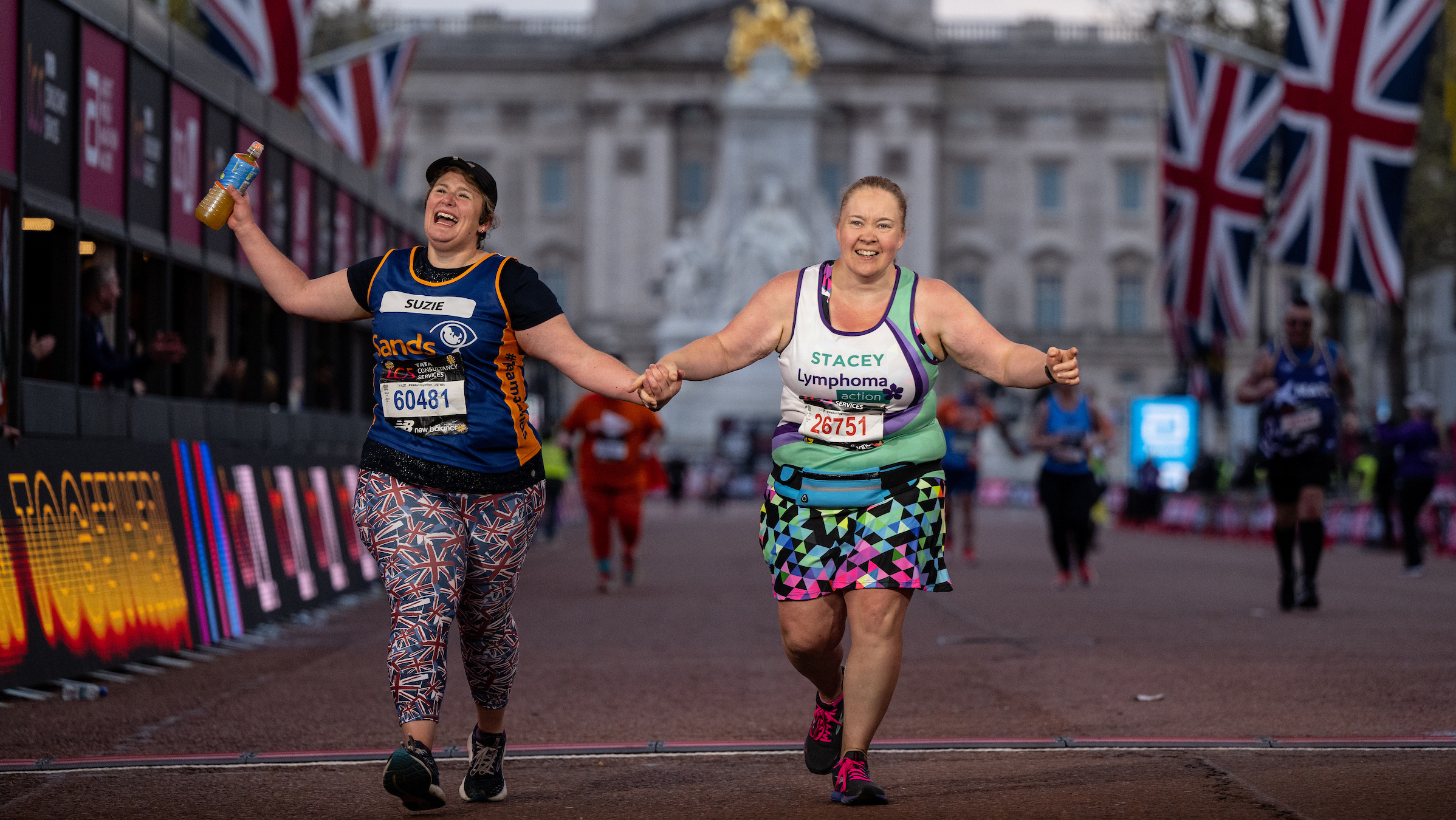
This plan is for you if… This is your first marathon and you’re simply aiming to get to the finish in one piece.
How often will I need to run? Three days a week, plus one day of core exercises.
Target time: Five hours.
Whether it’s your first marathon or your 40th, you get the same mix of excitement and trepidation when you sign up for the event. The main difference with your first is that there are a lot more unknowns about both training and race day, and the chances are you’re about to run more than you ever have before.
You might feel nervous about that, but the truth is that while the first week or so of following a running training plan might come as a bit of a shock, once that’s over you’ll settle into a routine and start to enjoy—even look forward to—your runs (honest).
You can also be confident that as long as you’ve given yourself enough time to train, you will be able to cross the finish line. A 14-week marathon training plan for beginners—like this one by James Heptonstall, captain of Adidas Runners London—can help anyone run a marathon.
This training plan will help by ensuring you’re doing the right amount of running to get fit for race day, but not overdoing it. It’s carefully designed so that any aspiring marathon runner can complete it and arrive at the start line in great shape come race day. The plan also includes a half marathon at the end of week eight, so you gain some experience of what a long race is like before your marathon.
Get the Coach Newsletter
Sign up for workout ideas, training advice, reviews of the latest gear and more.
We have lots more advice to help, gathered here in our essential guide to marathon training, but from the off we’d like to draw your attention to the best marathon running shoes and marathon diet advice—good news, you need to make sure you’re eating enough carbs to fuel all of this running.
We have all of the details you need to complete this plan further down this page, but to help you get an overview of what’s in store, or let people who are using the plan to look up their next session more easily, we begin with the pacing guide and weekly schedule.
14-Week Marathon Training Plan For Beginners
Pacing Guide
Easy: You can hold a conversation while running.
Steady: You can manage the odd sentence, but not speak for long. This is your marathon pace.
Tempo: You won’t be able to talk much at all. This is the kind of pace you might run a 5km at.
Strides: These are fast, short sprints at around 85% to 95% effort. The pace you would run a one-mile (1.6km) race in. Ease into these intervals for the first five seconds at a fast pace, before building up to speed, then slow yourself to a stop over the final five seconds..
Week 1
Here we go then! In these early weeks it’s almost as important to be nailing the core strength workouts on the plan as it is the running. You’ll need a strong body to handle the rigors of the running to come.
| Monday | Run 34min: 10min run and 2min walk, repeat three times until target time hit |
| Tuesday | Rest |
| Wednesday | 3km easy pace |
| Thursday | 8 core exercises, reps 10 or time 20sec |
| Friday | Rest |
| Saturday | 5km steady pace |
| Sunday | Rest |
Week 2
| Monday | Run 34min: 10min run and 2min recovery jog, repeat until time target hit |
| Tuesday | Rest |
| Wednesday | 3km easy pace |
| Thursday | 8 core exercises, reps 10 or time 20sec |
| Friday | Rest |
| Saturday | 7km steady pace |
| Sunday | Rest |
Week 3
This week involves your first taste of tempo running. It’s not easy to get the pace right when new to this, but try to keep it even between your reps, and don’t go out too fast in the first one!
| Monday | Run 26min: 5min tempo and 2min walk, repeat until time target hit |
| Tuesday | Rest |
| Wednesday | 3km easy pace |
| Thursday | 8 core exercises, reps 10 or time 20sec |
| Friday | Rest |
| Saturday | 9km steady pace |
| Sunday | Rest |
Week 4
| Monday | Run 26min: 5min tempo and 2min recovery jog, repeat until time target hit |
| Tuesday | Rest |
| Wednesday | 5km easy pace |
| Thursday | 8 core exercises, reps 15 or time 30sec |
| Friday | Rest |
| Saturday | 11km steady pace |
| Sunday | Rest |
Week 5
| Monday | Run 28min: 30sec stride and 2min recovery jog, repeat until time target hit |
| Tuesday | Rest |
| Wednesday | 5km easy pace |
| Thursday | 8 core exercises, reps 15 or time 30sec |
| Friday | Rest |
| Saturday | 13km steady pace |
| Sunday | Rest |
Week 6
Your long run this week is 15km and as these runs get longer, it’s the ideal time to start testing different running gels and other energy products. Once you’ve decided which ones you like, practice using them to get your gut used to digesting them on the move. You’ll also need to consider how you’ll carry the gels and liquids, since running with water is advisable for runs lasting more than 90 minutes. Our tried-and-tested picks of the best running water bottles, running belts and hydration vests will help you understand the options available.
Also, as the long runs get longer it’s a good time to focus on recovery work like stretching, yoga and foam rolling, which can make a world of difference.
| Monday | 3km steady pace |
| Tuesday | Rest |
| Wednesday | 5km easy pace |
| Thursday | 8 core exercises, reps 15 or time 30sec |
| Friday | Rest |
| Saturday | 15km steady pace |
| Sunday | Rest |
Week 7
| Monday | Run 30min: 5min tempo and 1min recovery jog, repeat until time target hit |
| Tuesday | Rest |
| Wednesday | 8km easy pace |
| Thursday | 8 core exercises, reps 20 or time 40sec |
| Friday | Rest |
| Saturday | 17km steady pace |
| Sunday | Rest |
Week 8
It’s race week! The plan is to do a half marathon on Sunday to help get you used to the atmosphere of mass participation events, but if you can’t make a live event you can try a virtual one to ensure you get a medal for all your hard work. Trust us when we say it really does help with motivation.
| Monday | 3km easy pace |
| Tuesday | Rest |
| Wednesday | 8km easy pace |
| Thursday | 8 core exercises, reps 20 or time 40sec |
| Friday | Rest |
| Saturday | Rest |
| Sunday | Half marathon |
Week 9
| Monday | Rest |
| Tuesday | Rest |
| Wednesday | 8km easy pace |
| Thursday | 8 core exercises, reps 20 or time 40sec |
| Friday | Rest |
| Saturday | 24km steady pace |
| Sunday | Rest |
Week 10
| Monday | Run 42min: 1min stride and 5min recovery jog, repeat until time target hit |
| Tuesday | Rest |
| Wednesday | 10km easy pace |
| Thursday | 8 core exercises, reps 25 or time 50sec |
| Friday | Rest |
| Saturday | 28km steady pace |
| Sunday | Rest |
Week 11
The long run this week is 32km, which is the furthest you’ll run before the big day itself. By now you hopefully have your race day kit in mind, so make sure to use it all on your long run for a dress rehearsal. To keep you motivated over the 32km, remember that after this week the runs get shorter until your marathon!
| Monday | Rest |
| Tuesday | Rest |
| Wednesday | 10km easy pace |
| Thursday | 8 core exercises, reps 20 or time 40sec |
| Friday | Rest |
| Saturday | 32km steady pace |
| Sunday | Rest |
Week 12
There’s a lot of rest this week after your 32km run in Week 11, and in general this is the beginning of your taper for the marathon. You’ll still be running regularly and doing long runs on the weekend, but overall you’ll be doing less work and getting your body primed for race day.
| Monday | Rest |
| Tuesday | Rest |
| Wednesday | 8km easy pace |
| Thursday | 8 core exercises, reps 15 or time 30sec |
| Friday | Rest |
| Saturday | 15km steady pace |
| Sunday | Rest |
Week 13
| Monday | Run 26min: 5min tempo and 2min recovery jog, repeat until time target hit |
| Tuesday | Rest |
| Wednesday | 5km easy pace |
| Thursday | 8 core exercises, reps 15 or time 30sec |
| Friday | Rest |
| Saturday | 10km steady pace |
| Sunday | Rest |
Week 14
It’s race week again and this time it’s the big one! There are a couple of short runs on the plan ahead of Sunday’s marathon, just to keep you moving, but the main aim is to take care of yourself. Eat well, carb-load in the final few days, sleep as much as possible, and steady those pre-marathon nerves by remembering all the work you’ve done—it’s time to enjoy the race.
| Monday | 5km steady pace |
| Tuesday | Rest |
| Wednesday | Rest |
| Thursday | 20min easy pace |
| Friday | Rest |
| Saturday | Rest |
| Sunday | Marathon |
About This Plan
This is one of three plans created for Coach by James Heptonstall. The sub 4-hour marathon training plan adds in another run a week, while the sub 3-hour marathon plan adds in a fifth session and introduces running drills.
Here’s a little more on the structure of the plan and advice on adhering to it.
How do you know what marathon time you should aim for?
“If it’s your first ever marathon it’s best to get an idea as you progress through the training of what pace you can sustain on your longer runs, then extrapolate from that,” says Heptonstall. “So if you can maintain 6min/km on long runs, you are likely to sustain that for the full marathon distance, and you’d be looking at 4hr 13min.”
Here’s a marathon pace chart, taken from our collection of running pace charts, to refer to.
| Finish time | Min per-km pace | Min per-mile pace |
| 7hr | 9:57 | 16:01 |
| 6hr 30min | 9:14 | 14:52 |
| 6hr | 8:32 | 13:44 |
| 5hr 30min | 7:49 | 12:35 |
| 5hr 15min | 7:28 | 12:01 |
| 5hr | 7:07 | 11:27 |
| 4hr 45min | 6:45 | 10:52 |
| 4hr 30min | 6:24 | 10:18 |
| 4hr 15min | 6:03 | 9:44 |
| 4hr | 5:41 | 9:09 |
| 3hr 45min | 5:20 | 8:35 |
| 3hr 30min | 4:59 | 8:01 |
| 3hr 15min | 4:37 | 7:26 |
| 3hr | 4:15 | 6:52 |
| 2hr 45min | 3:55 | 6:18 |
| 2hr 30min | 3:33 | 5:43 |
Why is it important to do different kind of runs in training?
“Rather than just putting in distance, variety in training—be it interval runs, easy pace or hills—keeps it enjoyable,” says Heptonstall. “It also will make you a better runner: as you are pushing yourself more in intervals and hill sessions, you will improve your lactate threshold and aerobic capacity, making you more comfortable running at a faster pace.”
How do I fit all this running in around other commitments?
“Fitting in the sessions is always difficult with work and other commitments,” says Heptonstall, “plus the lack of light in the winter months. For most people, Saturday and Sunday provide the most time to get that long run in. Other, shorter sessions can be done Monday to Friday, either in the morning or at lunchtime if your work has shower/changing facilities, and then after work.
“You can even run to work and turn your commute into a training session. The key is planning: work out the logistics and put the sessions in a diary. Then make sure you are prepared, so prep food and keep running kit at work to make sure the sessions are always easy to do and not stressful.”
How important is warming up before each session?
“Your runs should be preceded by an active warm-up, which involves things like skips, side skips, high knees, heel flicks, dynamic stretches and gentle strides,” says Heptonstall. “For the core sessions in these plans, try and do five to 10 minutes of cycling, running or rowing beforehand, then warm down with a five-minute jog.”
Helpfully, Heptonstall has also provided a routine to follow. Here’s how to warm up for a run.
Do I need to do anything on rest days?
“Rest days must be adhered to,” says Heptonstall, “but they can include active recovery, such as 20 minutes of easy swimming or cycling. Or try a five-minute ice bath followed by hot shower held over your legs for 30 seconds. Also, try to use a foam roller after running sessions and, if your budget allows, have weekly massages.
“To keep yourself in tip-top shape, it’s also a good idea to do some static stretching for 20 minutes each day. On training days, make sure you do that after the run or core sessions.”
We have plenty of sessions to follow, including 10-minutes of stretches for runners, post-run stretches, a yoga for runners sequence, and foam roller exercises for runners. It’s easy to skip these extra sessions, but your body will benefit enormously if you can make the time.
Core Exercises
On core workout days, choose eight exercises from the following.
Plank
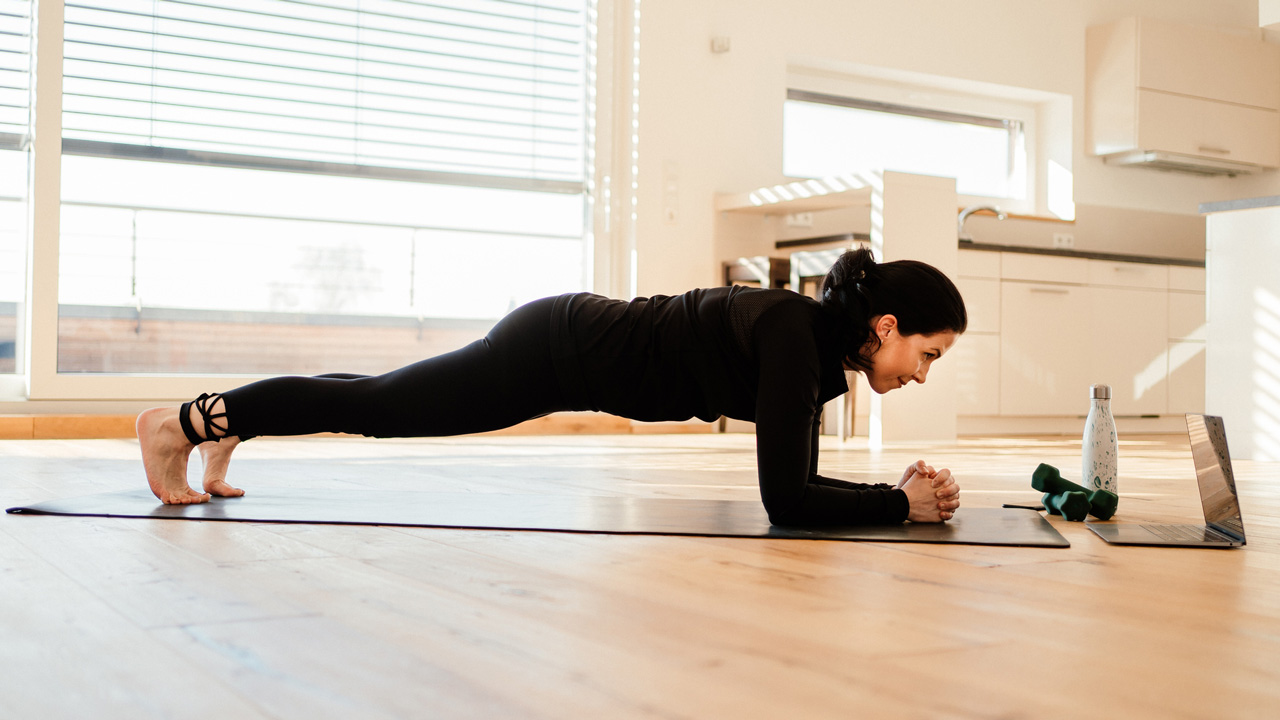
Lie face down supporting your body on your forearms and your toes. Engage your core so you form a straight line from your shoulders to your ankles. Hold this position.
Crunch

Lie back on the floor with your knees bent and feet planted. Use your core muscles to lift your shoulders off the ground, then lower slowly back to the start.
Wall sit
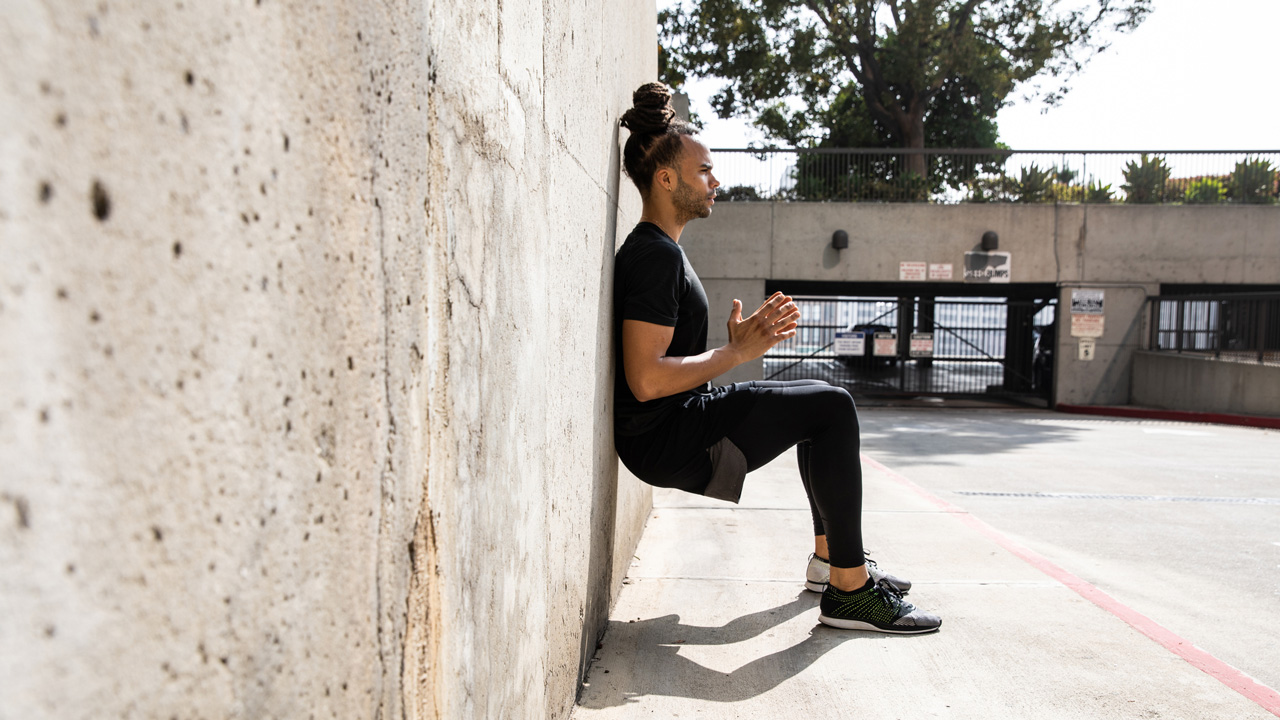
Rest your back against a wall and lower until your knees are bent at a 90° angle. Hold this position.
Press-up
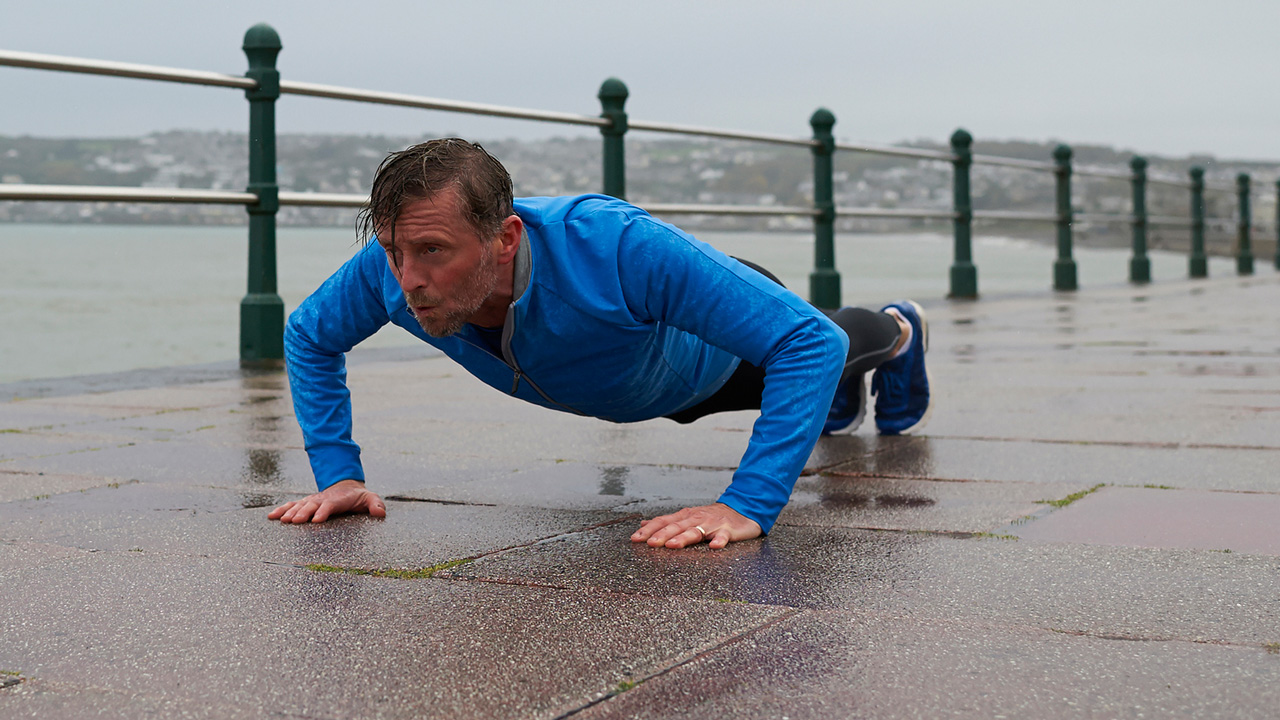
Begin by supporting your body on your hands and your toes, with your hands directly under your shoulders and your body straight from shoulders to ankles. Bend at your elbows to lower your chest until it’s just off the floor, then push back up.
Superman (arms only)
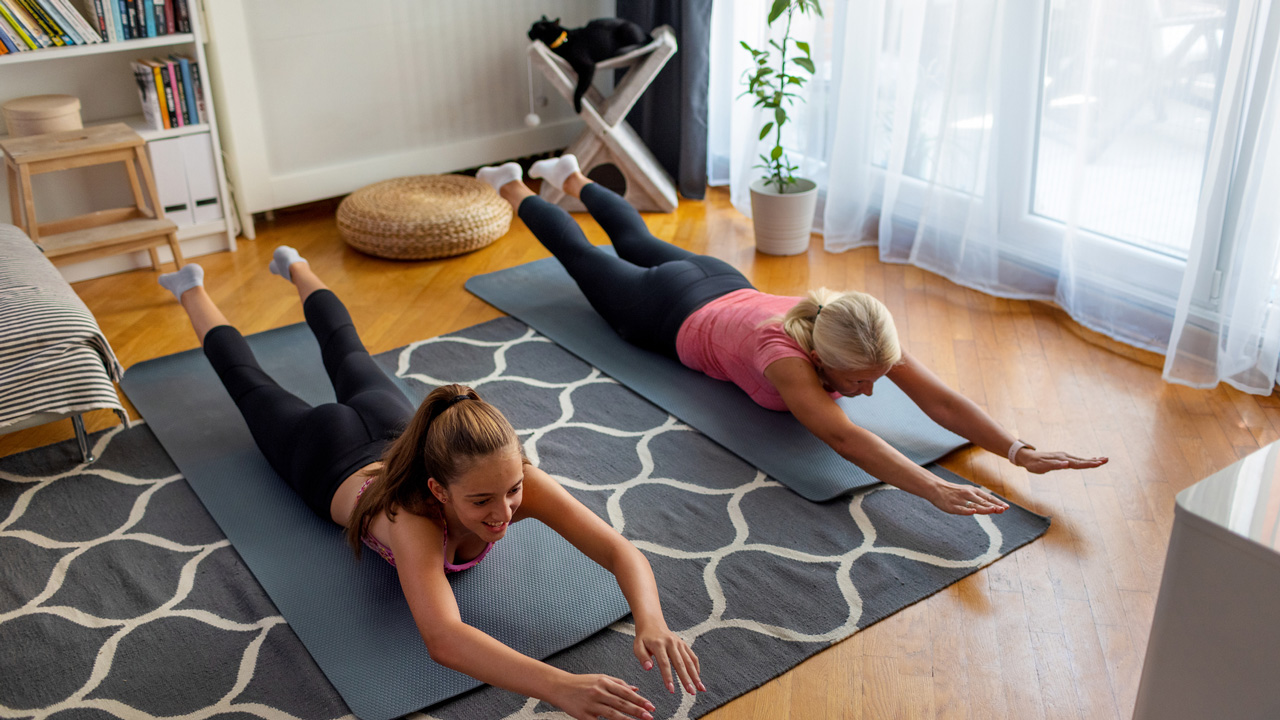
Lie face down on the floor with your arms extended in front of you. Raise both arms, then lower them so they’re hovering just off the floor.
Russian twist
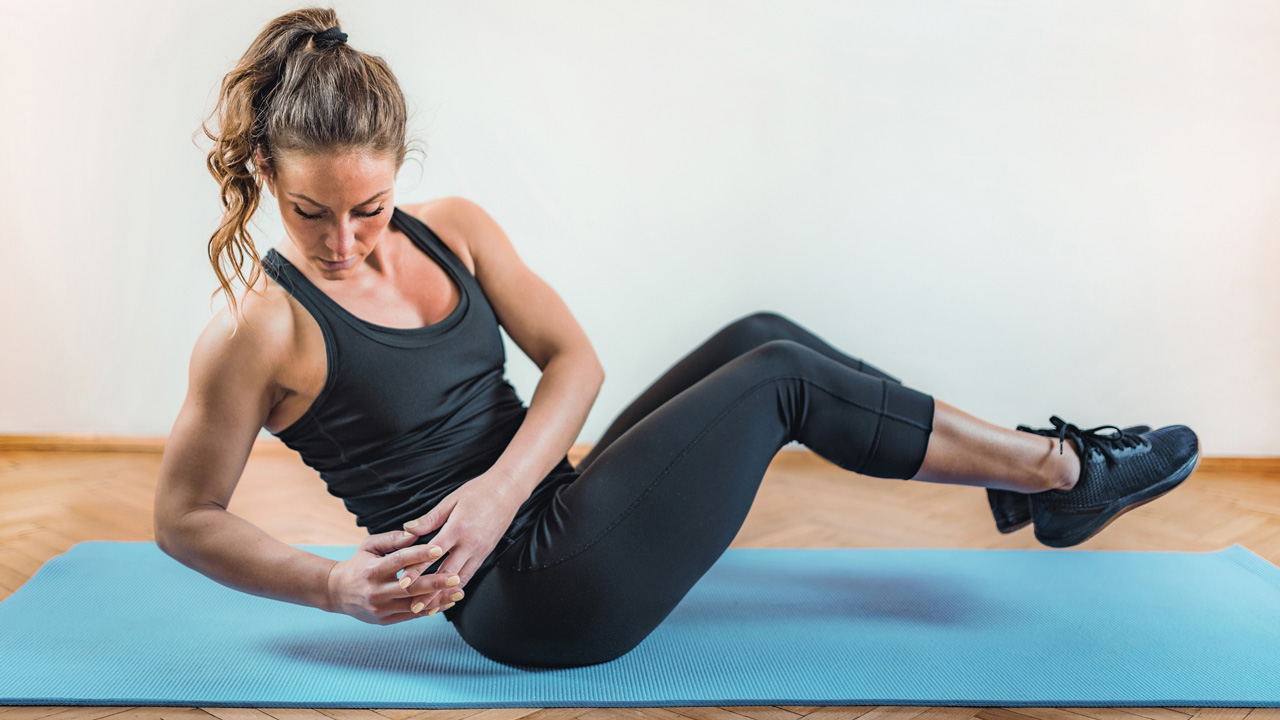
Sit on the floor with your legs bent and your feet raised, leaning back so your torso is at a 45° angle to the floor. Clasp your hands together in front of your belly, then take them over to the right side of your body, then over to the left.
Lunge
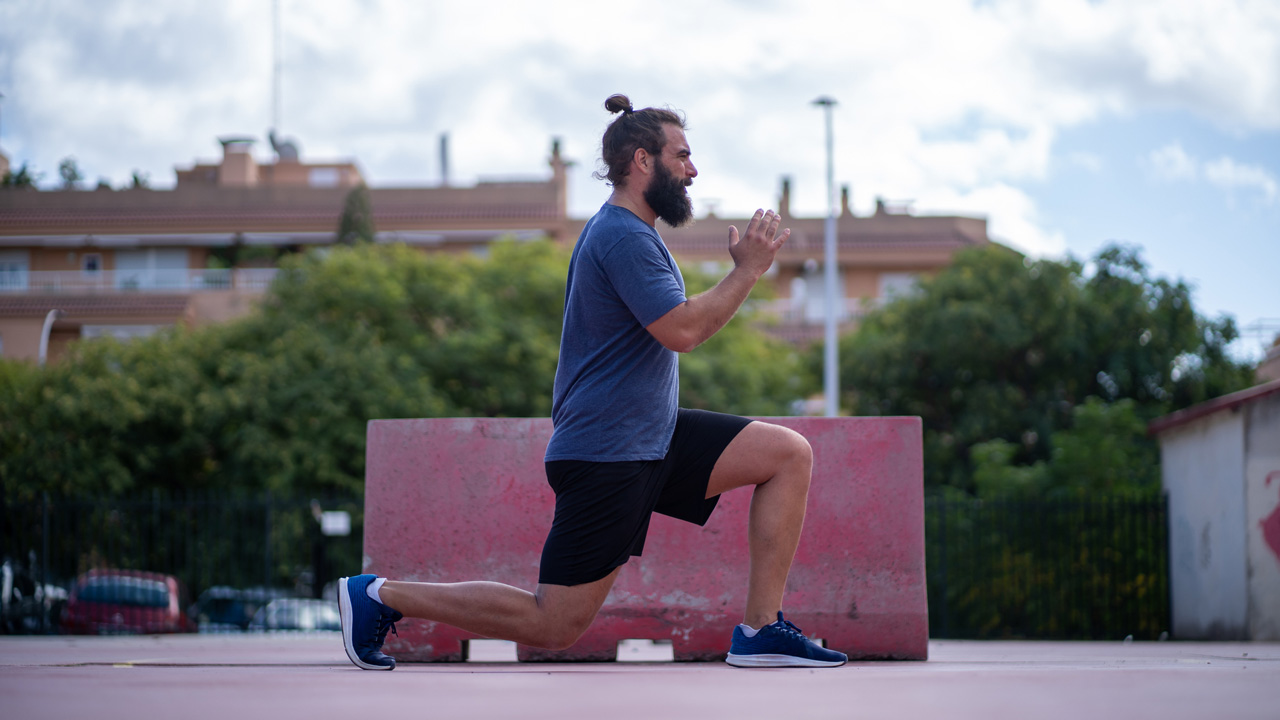
Stand with your feet shoulder-width apart. Take a big step forwards and lower until both knees are bent at a 90° angle, then push up and back to return to standing.
Sit-up

Similar to a crunch, but with sit-ups you lift your shoulders and head further off the floor so your chest comes all the way up to your knees.
Unweighted squat
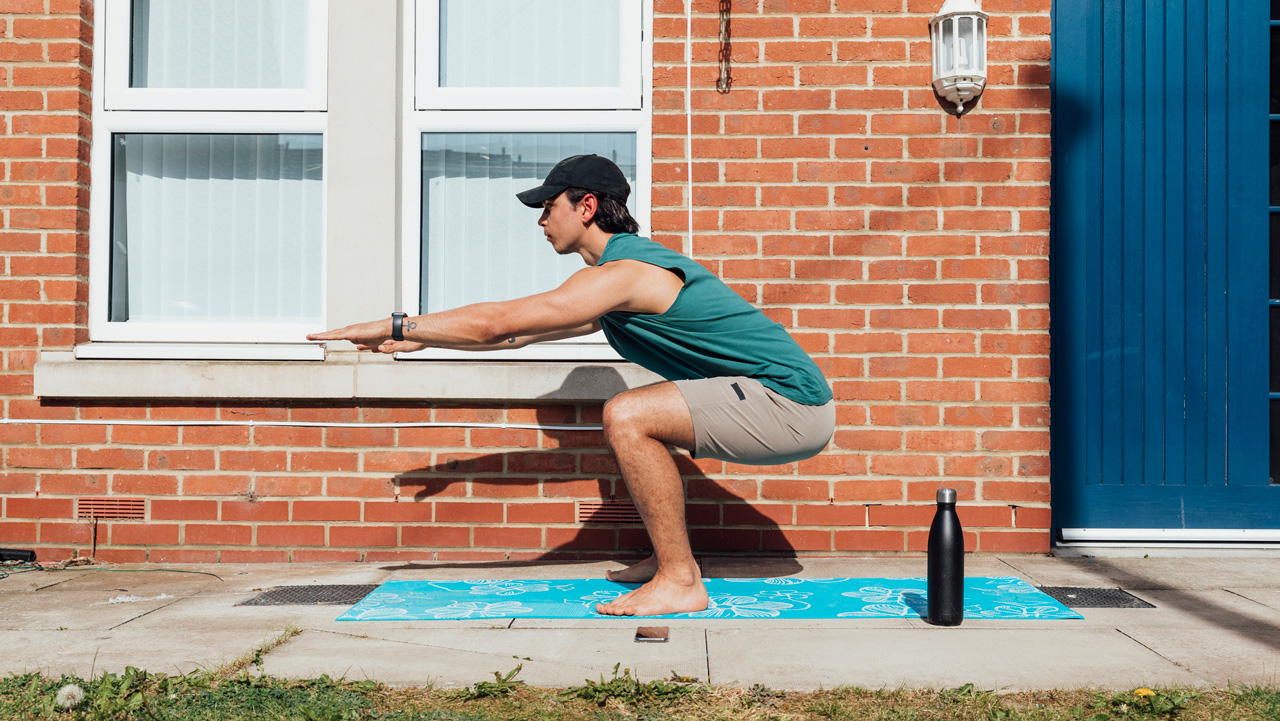
Stand with your feet hip-width apart. Lower, bending at the knees and pushing your hips backwards, until your thighs are at least parallel with the floor. Push through your heels to stand back up.
Side plank
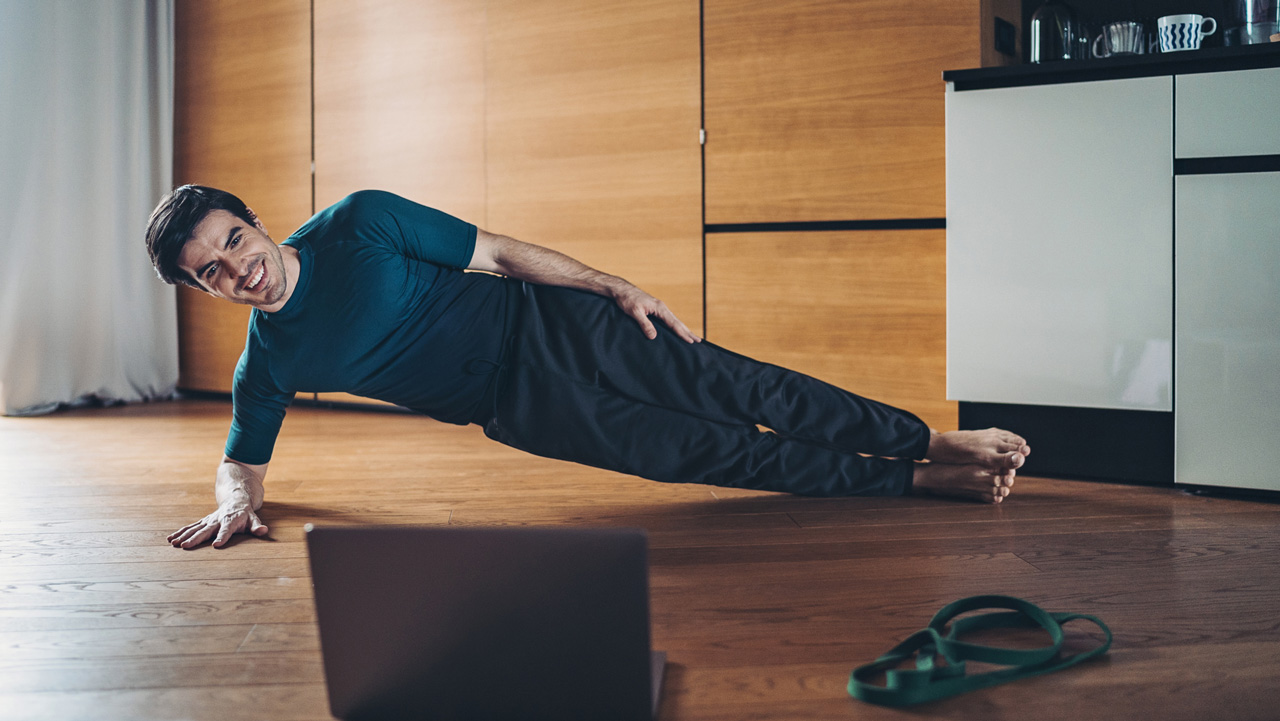
Lie on your side supported on your forearm and your feet, forming a straight line from your ankles to your shoulders. Hold this position for a set time, then switch sides.
Sit-out

Start in a high plank position with your feet shoulder-width apart. Lift your right hand, bring your left foot through under your body and extend it out to the side as you rotate your torso up and to the right. Return to the high plank position and do the same on the other side.
Step-up

Stand with a flat surface that’s just under knee height in front of you. Step up onto it, alternating which foot you lead with, then back down.

Nick Harris-Fry is a journalist who has been covering health and fitness since 2015. Nick is an avid runner, covering 70-110km a week, which gives him ample opportunity to test a wide range of running shoes and running gear. He is also the chief tester for fitness trackers and running watches, treadmills and exercise bikes, and workout headphones.









